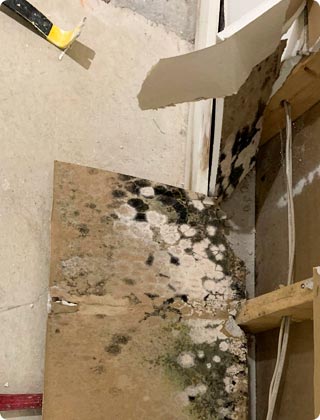
Is Mold Toxicity A Real Problem?
Mold toxicity and toxic mold poisoning are real!
The sooner we understand that there is a lot at stake with issues related to mold, the better for us all. Mold poisoning can trigger up to 65% of respiratory conditions/symptoms, especially asthma.
Not only that, how a mold colony can reduce food quality and carry other disease-causing organisms like bacteria should be read aloud to homeowners on every radio program to remind us of the danger in our hands.
Although not many admit it, most homeowners have had to deal with mold in their homes at one point or the other. Hence, questions arise on how mold grows and how harmful it can be.
Homeowners should know that no matter how clean a home is, it may contain invisible mold spores or an already established mold colony hidden somewhere under the carpet or behind the refrigerator. Therefore, there is a need to constantly check for mold to avoid it growing all over the place.
A dangerous reminder is that hidden mold in corners and spots of the home are unhealthy. You may be tempted to overlook that little bit of mold growing in your house.
But, inhaling or swallowing mold fragments can inflame the airways leading to mold toxicity symptoms like headaches, runny nose, skin rash, coughing, sneezing, etc. Prolonged exposure to high levels of mold can lead to reduced lung function and chronic health problems.
Mold is not only harmful to human health but also harmful to properties. Mold present in a house can reduce the value of the property by 3%. Therefore, mold should never be left unchecked.
It is almost impossible to prevent mold from growing in your home. However, you can make the environment inhospitable for them by keeping your home well ventilated at all times. Maintain low humidity in the house by using air conditioners and dehumidifiers, fixing water leaks, and always drying water spillage.
In a nutshell, mold will not grow in ventilated, dry, and clean areas.
Basic Facts About Mold Toxicity
Toxic black mold majorly causes mold toxicity. What is toxic mold? These groups of fungi are notorious for spreading airborne powdery substances called mycotoxins which are connected to some types of cancer, skin ulceration, and even foot infections.
Other types of mold are not as notorious, called non-toxic black mold. Although it is not related to any health issue, it can still devalue properties.
Types Of Toxic Mold
Toxic mold is a term used to refer to molds that are considered deadly to humans. There are hundreds of species of this kind of mold. However, they are broadly categorized into five.
They Are:
- Cladosporium
- Penicillium
- Fusarium
- Aspergillus
- Stachybotrys
Of the five categories listed, the toxins released by Stachybotrys Chartarum are the most deadly. It has been linked to some toxic mold illnesses such as hay fever and diseases as severe as liver damage, pulmonary edema, and in the most severe cases, brain or nerve damage and even death. It has also been tied to severe illness in infants.
What Does Toxic Black Mold Look Like?
You can differentiate between the types of molds by their colors. However, most molds usually have a dark green or black appearance. It has led to the misconception that all black molds are harmful.
There are different species of black mold, which are largely classified into harmless black mold and toxic black mold. Some of the ways you can know if a mold is dangerous are:
- Pay attention to the type of smell coming from the mold. Most toxic molds have an odor similar to rotten dirt.
- Notice the color of the mold. Toxic mold is usually greenish-black. Sometimes you may notice orange or brown spots with little furs on them.
- Pay attention to the texture. Toxic mold had a grayish soot-like texture or a slimy wet surface.
- Toxic mold in the house does not quickly go away. So when you clean up the mold and still notice stains, you should be cautious.
- Pay attention to your health. When you start experiencing respiratory issues, it may be time to check out that mold.
Effects Of Toxic Mold Poisoning On The Health
Toxic mold can be harmful to one's health in specific ways.
It could cause allergies and irritations, which lead to experiencing symptoms like runny nose, watery eyes, sinusitis, dry cough, wheezing, and skin rashes.
Severe mold infection can cause shortness of breath in some cases. For people with weakened immune systems, toxic mold can expose them to fungal infections.
Long Term Mold Exposure Danger
When exposed to mold for a long time, it could result in serious health complications like memory loss, insomnia, muscle cramps, hair loss, difficulty concentrating, weight gain.
Hidden Mold Damage To Structures
Molds are not only harmful to one's health but can also be damaging to structures. The damages done to structures by molds include:
- Cracks on walls
- Bulges on walls
- Toxic black mold on ceilings
- Soft spots on walls and ceilings
Mold Testing Methods
Mold Toxicity Test
Visible molds should be removed promptly in the home. However, after a visual inspection, and there is no visible mold, you should consider checking the quality of air in your home. You can choose from either a regular mold test or an air mold test.
Our air mold test service collects samples from specific places in your home and sends those samples to a lab to determine the type of mold you present.
These are methods you can use to test for mold;
Air Probe/Air Sampling
The air sample in the home is collected, and a control sample is also taken outside the home. Both samples are tested to determine if the indoor air sample has elevated levels of mold.
Surface Probe/ Lift Tape Sample
A tape is placed on surfaces to be tested to collect samples and then put on a micro-glass slide. The video will then be examined in a lab.
Tape Swab Test
This test is used to determine the type of mold present. It is not used as frequently as the others.
Doing a mold toxicity test will save you unnecessary health challenges and maintain the value of your properties as prompt actions are taken.
Conclusion
Mold toxicity is a problem affecting many homes, and if left unchecked, can lead to severe health issues, property devaluation, and many other issues.
In many major cities of the United States, O2 Mold Testing can help you solve those mold-related issues. Our services include mold inspection, mold detection, mold testing, etc. Call us at 888-202-1680


